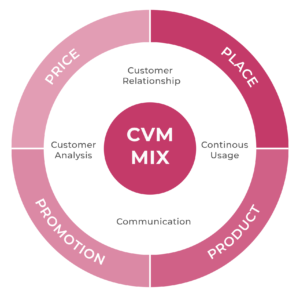This section systematizes CVM and proposes a comprehensive framework for understanding it.
Connection Between CVM and Marketing
Customer Value Management is not an isolated discipline; it is an integral subset of the broader discipline of Marketing.

Figure 2.1. What is Marketing: Philip Kotler’s 4P Marketing Mix
Philip Kotler, a renowned marketing expert, significantly contributed to the field with his 4Ps framework (Product, Price, Place, Promotion) foundational in marketing (see Figure 2.1). For a comprehensive exploration of CVM’s roots within marketing, consider reading the latest edition of Philip Kotler’s work [1], which provides valuable insights into the ever-evolving discipline of Marketing. The 4Ps identified by Kotler are:
-
- Product: The creation of offerings that meet the needs and desires of the target market.
- Price: Setting a price that reflects the perceived value of the product while considering market demand and competition.
- Place: Making the product available in the market and distributed to locations where it is convenient for consumers to buy it, physically or virtually.
- Promotion: Managing price changes, reaction to the market and stimulation of the demand with campaigns to maximize the overall sales.
Moving Beyond 4Ps of Marketing
While marketing lays the foundation for CVM, CVM extends well beyond the traditional 4Ps. Specifically, CVM places much greater emphasis on aspects that were not so relevant at the time of 4Ps invention, but are extremely important nowadays. The specific characteristics which CVM emphasizes are:
-
- Customer Analysis: Many customers that can be individually analyzed;
- Continuously Used: The products are used continuously and regularly;
- Customer Relationship: Ongoing customer relationships with renewal cycles and multiple purchases (either as a subscription or simply a regular purchase).
- Communication: Direct communication with individual customers via various channels: either via telephone (call center, telemarketing) or digitally (email, apps, web, etc.), and periodic interactions in person (in retail stores or in other face-to-face meeting formats).
These four additional ‘C’s—Customer Analysis, Continuous Usage, Customer Relationship, and Communication—significantly expand upon the original 4Ps. It is a much deeper and wider framework that builds on top of marketing but adds may important twists. It redefines direct marketing for the modern era, driven by big data, generative AI, digital transformation, and cloud technologies.
Many industries are experiencing the fact that “marketing with CVM characteristics” is gaining in importance. Such industries are:
-
-
- Telecommunications
- Media and television
- E-commerce
- Gaming and mobile apps
- Fintech and banking
- Insurance
- Energy
- Automotive
- Consumer products, especially with digital add-ons
- Etc.
-
What is CVM: A 4P+4C Framework
The CVMBoK proposes the 4Ps+4Cs framework to conceptualize and define modern Customer Value Management (see Figure 2.2.).

Figure 2.2. What is CVM: 4P (Product, Price, Place, Promotion) + 4C (Customer Analysis, Continuous Usage, Customer Relationship, Communication)
Customer Value Management, a business management discipline, encompasses eight key aspects:
-
- Product: Creating offerings that meet the specific needs and desires of the target market.
- Price: Setting pricing that reflects the product’s perceived value while considering market demand and competition.
- Place: Ensuring product availability in physical locations and online platforms for customer convenience wherever they are.
- Promotion: Using targeted marketing campaigns to stimulate demand and manage market reactions.
- Customer Analysis: Using data analytics to understand customer behaviors, needs, and preferences, thereby enabling tailored product and service offerings.
- Continuous Usage: Encouraging regular use of the product by addressing continuous customer needs and designing commercial strategies that promote easy adoption and spending growth.
- Customer Relationship: Developing strong, lasting relationships with customers to boost loyalty and lifetime value, while continuously providing support and education.
- Communication: Effectively communicating the product’s benefits across various channels to reach the customer in a timely fashion and through the most effective media.
CVM is a holistic discipline integrating product marketing, development, pricing, distribution, promotional activities, communication, branding, and customer-focused processes. This integration aims to create a strong, sustainable relationship with the customer base. It may be tempting to treat CVM narrowly by focusing only on customer retention and upselling/cross-selling. However, this approach hides the true nature of the discipline. Let’s recognize the complexity of CVM and address it accordingly.
The Broad Scope of CVM
CVM encompasses ongoing operational and transformational activities related to the 4Ps+4Cs, spanning approximately 17 distinct areas (see Figure 2.3).

Figure 2.3. ~17 areas coordinated by CVM
The Dual Nature of CVM
Beyond the 17 areas, CVM embodies a crucial Customer-Company duality. To truly grasp the essence of customer value management (CVM), one must view it from two major perspectives:
- Company perspective: CVM is oriented towards achieving business results, such as maximizing revenue;
- Customer perspective: CVM seeks to address and fulfill customer needs in the best way possible.
This duality persists across the entire discipline, with different companies placing emphasis on different aspects of this dual nature. Some companies practice CVM mainly from a business-focused perspective, while others firmly take a customer-centric perspective. The balance between these two approaches varies, and there is no single right or wrong approach – it depends on the specific context and objectives of each organization.
In summary, CVM is a management discipline encompassing 4P+4C, coordinating fourteen areas, and balancing Customer-Company duality. It aligns efforts across the entire customer lifecycle.
Modern, digital, data-rich business environment strongly favors an enriched definition of marketing with CVM characteristics. The future of business success lies in customer value management excellence.
Previous: Customer Value Management Body Of Knowledge (CVMBoK)


